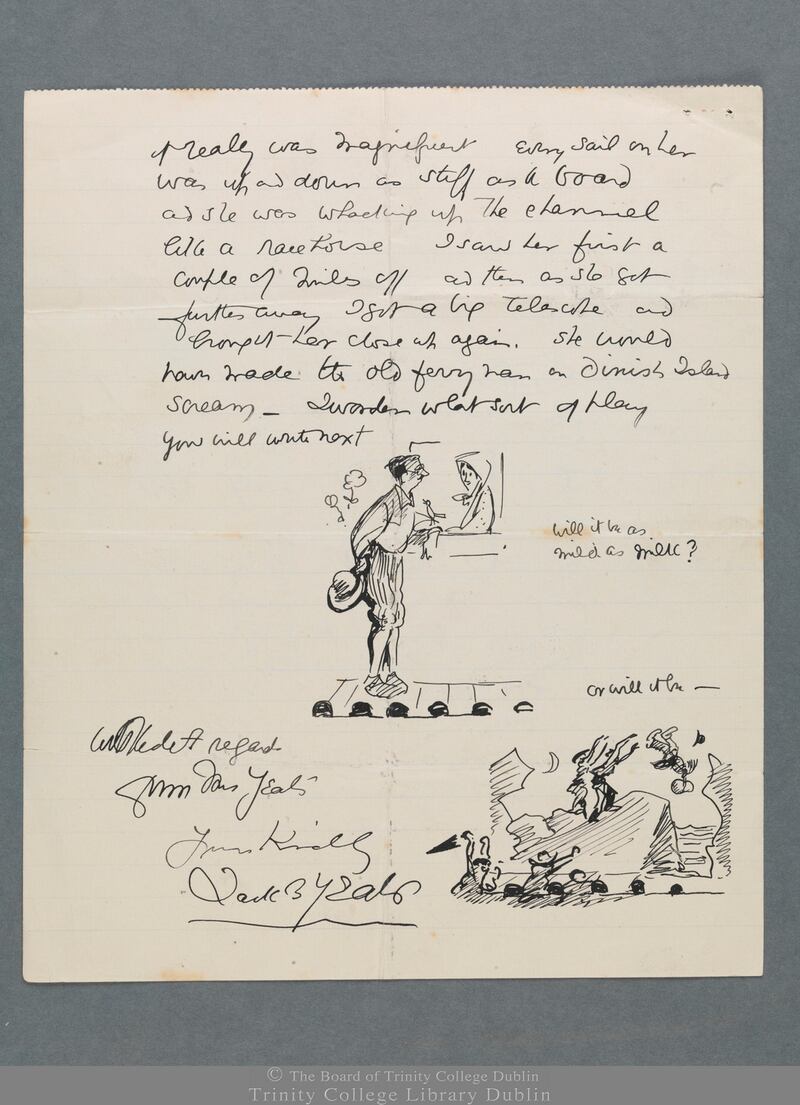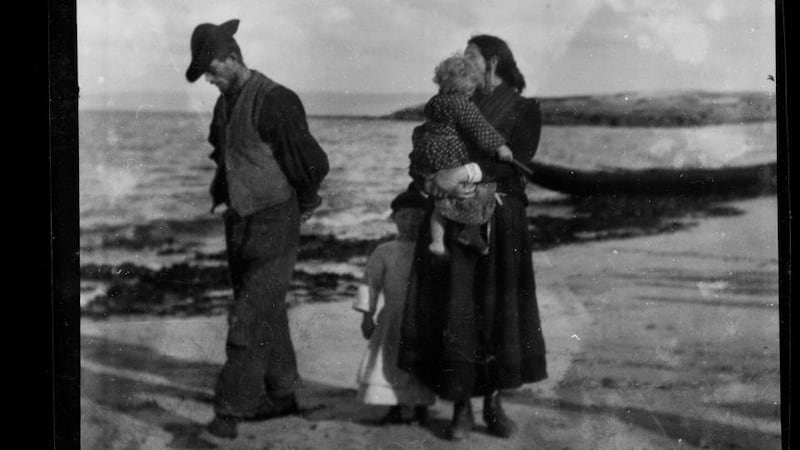The artist Jack B Yeats, a close friend and collaborator of JM Synge’s, wrote a letter to the dramatist in the wake of the riots that greeted the Abbey Theatre’s premiere of The Playboy of the Western World in late January 1907. He also drew a small cartoon.
In the first scene, a man, holding his hat behind him, his knees touched together in a posture of nervous modesty, leans against a window to talk with a young woman, a small bird perched on his arm. “Will it be mild as milk?” Yeats writes, “or will it be…”
In the second scene, a jeering audience with raised fists watch the man being tossed off a high cliff into the sea. The man is upside-down, mid-air, his hat flying off into a tall wave.
As his career had progressed among the fraught cultural conditions of the Irish Revival, Synge increasingly gravitated towards the second option. His literary output began with a bucolic Romanticism, taking a turn of experiments through Decadence and symbolism. But it was the pressures of a modernising Ireland that urged him into what the scholar Mary Burke has recently called a form of “modernist provocation”.
Synge moved to Germany as a young man, and then to Paris. The riots over the first performance of Alfred Jarry’s Ubu Roi (1896), an avant-garde play considered to be an assault on the audience, would certainly have come to Synge’s attention. In fact, Jarry’s collapsing of the distinction between noble and ignoble, between “primitive” and civilised, finds a striking afterlife in Synge’s own riot-inducing masterpiece just over a decade later.

Synge’s fantasy, imagination and lyric flights of poetry were the tender side of his vision; but for every sweet word there was a sharp, brutal undercurrent, a violence and earthiness that all poetry, and all life, should be rooted in. This was at the heart of his work.
Whereas some writers and audiences wanted a “purely fantastic, unmodern, ideal, spring-dayish, Cuchulanoid National Theatre”, what Synge valued most in the life of the peasantry was what he saw as their savage, ironic humour, their imaginative freedom, and their brutality. This, he saw, was their chief challenge to the homogenising tendencies of modernisation; their alterity was in their opposition to the values of the imperial project and also to the values of the middle classes, who were “an ungodly ruck of fat-faced, sweaty headed swine”. If he was to hold a mirror up to the nation, it would not be while the people were “going to Mass on a fine… Sunday morning”.
This year marks 150 years since Synge was born in Rathfarnham, Co Dublin, into a wealthy Protestant family with long-held connections to the gentry and to the Church of Ireland. Members of the Plymouth Brethren, the Synge family were led by their mother, Kathleen.
Early on, Johnny (as he was known to his relatives) was uncomfortable with the practices of his Anglo-Irish family. In 1885 his brother Edward began evicting tenants in Cavan. Johnny, at the age of just 14, argued strongly with his mother about the rights of the tenants, until she asked him: “What would become of us if our tenants… stopped paying their rents?”
He did manage some small victories, among them was convincing his mother to change the family subscription from the Daily Express to the more liberal Irish Times, which she nevertheless considered “a rebel paper”.
Shock and outrage
When Synge undertook the first in a series of trips to the Aran Islands, he went with the socialist ideas of William Morris and the philosophy of Spinoza in mind, and also with his reading in comparative folklore, anthropology and (perhaps surprisingly) occultism.
The Synge Papers, held in the archives of Trinity College Dublin, provide a rich insight into the influences of a writer who, despite the many books written about his work, has yet more to reveal. Indeed, these archives change the ways we read his published and performed works; in The Aran Islands alone, there are scenes and sentences that bear the influence of the French Symbolist writers, the major works of socialist thinkers, theories of occult initiation and telepathy, and the mystical practices of Sufism and theosophy.

In one memorable sequence, Synge seems to be possessed by the lure of the island itself. He writes about the “psychic memory” of buildings, and dreams of being whirled into an uncontrollable dance, as though the island is puppeting him: “I struggled to free myself, but seemed only to increase the passion of the steps I moved to. When I shrieked I could only echo the notes of the rhythm.”
Synge’s idealisation of the peasantry came with a difficulty. His socialism kept the lived conditions of the people close in his mind. When he travelled with Jack Yeats in “the Congested Districts” of Ireland on a commission from the Manchester Guardian, he lamented that the Irish peasant culture he loved was “bound up with a social condition that is near to penury”. In a notebook for his prose narrative The Aran Islands, he drafted an ironic dedication: “To the little Irish pigs that have eaten filth all their lives to enable me to wander in Paris these leaves are dedicated with respect and sympathy.”
When he came to write plays, Synge’s depictions of the peasantry were often met with shock and outrage. Though his one-act tragedy Riders to the Sea went down well, his comedies were provocative and scandalous. Women walked out and left their husbands, priests were put into sacks and beaten, pious saints were mocked, murderers were exalted as heroes.
One of Synge’s early critics, the American scholar Stuart Sherman, noted that the audience of Synge’s plays is left in “ironical bewilderment”. Whereas in classical comedy laughter might be a corrective, aimed at punishing the vices or mocking the affectations of various characters, Synge’s was an “outlaw comedy”, with “gypsy laughter coming from somewhere in the shrubbery by the roadside, pealing out against church and state, and man and wife, and all the ordinances of civil life”.
That irony, his brand of harsh, irreverent satire, was born out of what he most valued in the peasant culture of Ireland. Subjected to what he saw as “demoralising” relief works and schemes of modernisation that risked homogenising local cultures, Synge took heart in the laughter of the families he visited and the scenes he witnessed whilst reporting from the “Congested Districts” of the western seaboard: “It shows that, in spite of relief-works, commissions, and patronizing philanthropy – that sickly thing – the Irish peasant, in his own mind, is neither abject nor servile.”
Political radicalism
Over the course of the last century, however, Synge’s political radicalism was largely overlooked. His close friend WB Yeats described him as a man “by nature unfitted to think a political thought”, and that image took hold. Far from being merely an Anglo-Irish aesthete, or what Christy Mahon in a draft of Playboy calls a “tweedy suited poet”, Synge was a fierce writer. He sits within our prevailing image of the Irish Revival as a wolf in sheep’s clothing.
Still, many writers recognised his subversiveness, and many scholars have continued the project of his reassessment. Teresa Deevy carried his radicalism forward in The King of Spain’s Daughter. Ezra Pound praised him; and Beckett thought him the finest Irish dramatist. As the scholar Susan Cannon Harris has shown, Synge’s drama influenced leftist theatre groups across Europe and was adapted by Bertolt Brecht into a revolutionary narrative in his play Señora Carrar’s Rifles (1937).
Ralph Vaughan Williams set Riders to the Sea to music, resulting in an opera with symphonic qualities that drew on the musicality of Synge’s structuring and language. Synge had studied music and counterpoint, and was an excellent violinist. Djuna Barnes, author of Nightwood (1936), drew Synge’s characters in a style more closely related to fin de siècle decadence than peasant costume, and Synge’s poems inspired some of Harry Clarke’s most exquisite stained-glass windows.
Though it was hardly meant as a compliment, Flann O’Brien signalled Synge’s influence when he noted that Synge’s “fakery” wasn’t long confined to the stage: “the curse has come upon us, because I have personally met in the streets of Ireland persons who are clearly out of Synge’s plays”.
For many years, Synge’s drama was too close to home. Later, he was mistakenly aligned with an image of Romantic Ireland that a rapidly modernising nation found unpalatable. The power of his vision, and the image of the country he portrayed, was often too hot to handle, and so it was by turns rioted against, or neutralised.
In the year of his 150th anniversary, his shattering romances and his desolate, beautiful language have the power to provoke, to show us the sorrow of disillusionment and the importance of wildness, resistance and imagination. As WB Yeats wrote, Synge’s writing was the “rushing up of the buried fire, an explosion of all that had been denied and refused, a furious impartiality, an indifferent turbulent sorrow”.
JM Synge: Nature, Politics, Modernism, by Seán Hewitt, is published by OUP Oxford









